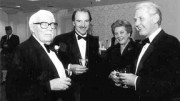The four men who discovered silver in the woodlands of Cobalt, Ont., at the turn of the last century are among seven new inductees into the Canadian Mining Hall of Fame, all of whom will be honoured at an awards banquet on Jan. 16, 2003, at the Royal York Hotel in Toronto.
James McKinley, Ernest Darragh, Alfred LaRose and Tom Hebert found one of the largest silver deposits in the world, and their induction occurs at a time when the town of Cobalt is celebrating the 100th anniversary of the discovery of silver in the area. Historically, the region’s mines produced more than 460 million oz.
The other inductees include: Richard Ennis, former long-time manager of the McIntyre gold mine in Ontario’s Porcupine camp; James Gill, renowned former professor at McGill University; and Vladamir Mackiw, the highly accomplished metallurgist at Sherritt-Gordon Mines.
James McKinley Ernest Darragh Alfred “Fred” LaRose Tom Hebert
As the story goes, James McKinley and Ernest Darragh were contractors providing lumber for a railway being pushed north through the thick Ontario bush. In early August 1903, the two partners were scouting for trees suitable for railway ties. As they passed through a rock cut, their curiosity was piqued by an off-pink stain. They stopped to pick up a few loose pieces of rock, which were heavy with blackened metal flakes.
McKinley and Darragh sent these samples for examination to Ottawa and Montreal. The Ottawa “expert” reported bismuth; the Montreal assayer reported native silver assaying 4,000 oz. per ton. It seems the black colour of the soft metal was caused by tarnished silver.
Cobalt’s second silver discovery came a few weeks later, in mid-September. Alfred LaRose was a blacksmith sharpening drill steels for the railway builders. He had previously worked in Quebec mines. LaRose had a 50-50 partnership with his employer to keep a prospector’s eye open for minerals. LaRose also noticed a pink-stained rock and took samples, which he thought contained copper. The sample was sent to Toronto, where it was classified as rich in nickel.
Fortunately for Cobalt, and the Canadian mining industry, the first full-time Ontario provincial geologist, Willett Miller, followed up on the nickel discovery with a visit to the district. Miller found that LaRose had exposed four veins. Three of the veins contained massive native silver, including, as he reported, chunks “as large as stove lids or cannon balls.” The pink colour was “cobalt bloom.”
Tom Hebert, a French-Canadian working on the railroad, prevailed on the geologist to examine a vein in the face of a cliff. Hebert’s discovery became the richest silver mine in the Cobalt camp and one of the most productive in the world. Affectionately labeled “Big Nip,” the mine yielded more than 91 million oz. silver over 40 years.
In 2003, the town of Cobalt will mark the 100th anniversary of the discovery of a silver bonanza that, to this day, reverberates throughout the Canadian economy. In recognition of the impact of the events of a century ago, the Cobalt silver camp has been made a Canadian Heritage District.
As a source of silver riches, the Cobalt area led the world in producing a phenomenal 460 million oz. — that’s about US$2 billion at today’s prices. In 1911, Cobalt’s peak year, 34 mines produced more than 30 million oz.
Cobalt served as the stimulus of a long period of growth in the Canadian mining industry. The outflow of prospectors and capital from the region’s silver riches also confirmed the enormous mineral wealth of Canada’s Precambrian Shield. The growth of Canadian mining, in turn, established the skills and finances that made the industry a world leader.
Richard Ennis (1881-1951)
Richard Ennis was among a select number of larger-than-life personalities who appeared in the early days of the 20th century, when an explosion of mineral discoveries began a period of unprecedented growth for Canadian mining.
Born in Aspen, Colo., Ennis came to Canada in 1911 to build and manage a 300-ton-per-day mill at the crisis-ridden McIntyre gold discovery in the new Porcupine camp, near Timmins. Ennis stayed with McIntyre for the next 40 years.
His ability to solve difficult problems, combined with a talent for innovation, earned him immense respect as a mine manager. In its early days, the McIntyre mine faced innumerable problems. A historian once wrote: “It is doubtful if any major mining corporation anywhere was ever established on a shakier foundation.”
Ennis once ran to the bank with hot bullion bars to cover a payroll, and on another occasion he disappeared underground to hide from creditors.
But he prevailed, and went on to set a long list of firsts in mining and milling practices.
His record of 38 continuous years as manager of the same mine is believed to be the longest in the Canadian industry, possibly the world. McIntyre was the first mine in Canada to hire a metallurgist and the first to hire a graduate engineer as mine superintendent.
Under Ennis, McIntyre was the first mine in Canada to use rubber liners in milling, and it was the first in the Porcupine camp to apply square-set and cut-and-fill stoping underground.
Also, a member of Ennis’s team developed “gunitting,” the process of spraying roads with concrete to provide a measure of stability.
Under Ennis, McIntyre also adapted and introduced flotation to gold milling, and it was the first mine in Ontario to sink a shaft to below 4,000 ft.
Ennis was always an innovator in mine safety, establishing early procedures that ensured daily reports on safety conditions underground, a standard that is common today.
McIntyre became famous when it tackled the serious health problem of silicosis. European researchers had discovered that the scarring of lungs caused by silicosis was the result of a complex chemical reaction between silica particles and lung tissue. A McIntyre research group, which included the world-renowned Banting Institute of the University of Toronto, pursued a way of eliminating or reducing the solubility of silica particles. Their solution: small quantities of metallic aluminum dust added to the air in another Ennis innovation — the 2-stage dry, through which miners passed when they returned to surface. The non-profit McIntyre Research Foundation was formed to further the use of the treatment throughout the mining industry.
James Edward Gill(1901-1980)
Scientist, teacher and discoverer-developer of mines, James Gill made major contributions in every area he touched throughout a long career in mining.
To hundreds of mining professionals now scattered throughout the world, he was the “professor,” who, for more than 40 years, taught and encouraged them to achieve the highest standards in their careers. Today, many of Gill’s former students, including grandson James Gill, president of Aur Resources, are prominent in the industry.
The leadership he displayed in education is demonstrated by two innovations: an applied master of science program in mineral exploration; and the first analytical laboratory for the application of geochemistry to mineral exploration. Both were introduced at McGill University, where Gill joined the Department of Geological Studies in 1929. He retired in 1969 as professor emeritus.
As a teacher and scientist, Gill’s main interest was the geology of ore deposits. He was keenly interested in structural geology, formulating the concept of a “structural province” and using this to define the fundamental sub-divisions of the Canadian Shield.
He published more than 50 technical papers and served as managing editor at the 24th International Geological Congress, which resulted in a bookshelf-length set of volumes on geoscience.
Gill also established a record of hands-on achievements in the mining industry, including the discovery of deposits that became mines and expansions of producing mines.
In 1929, Gill, together with the late Dr. W.R. James, a famous mining consultant (and an early inductee into the Canadian Mining Hall of Fame) discovered deposits of high-grade iron ore that, years later, led to the opening up of northern Quebec and Labrador. That exploration project was a daring undertaking, as it was one of the first major air-supported programs.
Gold in northwestern Quebec was another fruitful interest. Gill was instrumental in discovering at least three gold mines and contributed to many other successful mines as a consultant and advisor. His extensive work in the field included finding: coal on Vancouver Island; fire clays in Pennsylvania, the Caribbean and South America; and various mineral resources in the Northwest Territories and Ontario’s Red Lake district.
During the Second World War, when Canada’s mining industry was mobilized to provide essential minerals and metals, Gill contributed to the development of Canada’s only source of chromite.
Gill was born in Nelson, B.C., and attended the University of British Columbia and then McGill, where he graduated in 1921 with a bachelor of science degree in mining engineering. He spent two years as a mining engineer in British Columbia before obtaining his doctorate at Princeton University in 1925 and embarking on his academic career as assistant professor at the University of Rochester.
Vladimir Nicolaus Mackiw (1923-2001)
Vladimir Mackiw’s life is an outstanding example of how one man can contribute to the growth of a country through the application of advanced and innovative technology.
His accomplishments as a scientist, inventor and industrialist are demonstrated daily throughout the world in some 25 commercial plants that use the technology developed by the research team he created and led in the Sherritt organization.
Mackiw spent almost half a century at Sherritt, where he left an indelible mark. There is a large complex appropriately named the Mackiw Materials Centre in Fort Saskatchewan, Alta., along with a library containing more than 50 published technical papers which Mackiw either wrote or co-wrote.
Mackiw enjoyed the pleasure of inventing and developing a process, carrying it forward through pilot-plant testing and then into design and commissioning of a commercial plant, and finally into operations.
Early in his career, he collaborated with professor Frank Forward of the University of British Columbia to define the necessary conditions for pressure leaching of nickel-cobalt sulphide concentrates in ammoniacal solutions. His team worked out the chemistry for separating nickel from cobalt and then the conditions for recovering nickel and cobalt as powders using hydrogen reduction.
Further research in powder metallurgy led to development of powder rolling processes for production of coins, as well as specialty composite powders for seals on jet engines to prevent wear. A composite alloy was also developed for Canada’s one-dollar coin.
Developments in acid pressure leaching of gold ores and nickel-cobalt oxide ores, together with pressure leaching of zinc and copper sulphides, were among his contributions in extractive metallurgy.
The pioneering work of his research group established pressure hydrometallurgical process technology as both clean and economical for nickel, cobalt, copper, zinc, refractory gold and uranium.
Born in Stanislawiw, Ukraine, he studied at the Universities of Breslau and Erlangen, obtaining a master’s degree in chemistry in 1948, and continued with post-graduate studies at the University of Louvain.
He came to Canada in 1948. His first job was in Winnipeg as a chemist at a gold mine. After a short stopover with the Manitoba Bureau of Mines, he moved to Ottawa to join Sherritt-Gordon Mines, where he rose rapidly from research chemist to executive vice-president.
His wide-ranging responsibilities included the metals division, nickel and cobalt refineries, rolling mill and coinage products, special metal and chemical products, technology licensing, the research centre, and engineering and maintenance services.
His outstanding contributions to the nickel, cobalt and copper industries and to science were recognized internationally.




Be the first to comment on "Canadian Mining Hall of Fame honours Cobalt pioneers, three others"